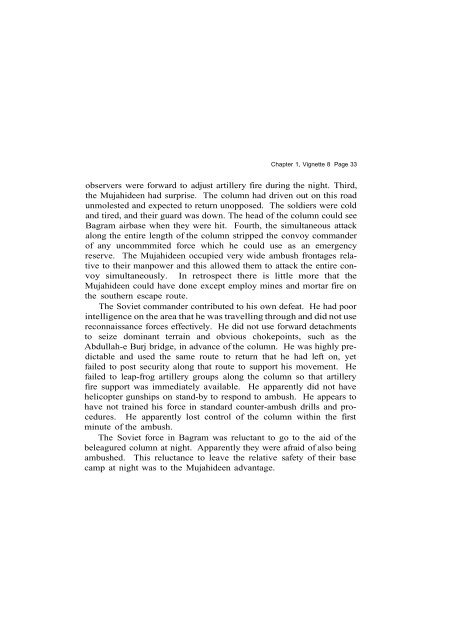- Page 2:
THE OTHER SIDE OF THE MOUNTAIN: Muj
- Page 5 and 6: Chapter 3: Shelling Attacks 105 Vig
- Page 7 and 8: Chapter 14: Urban Combat 365 Vignet
- Page 9 and 10: FOREWORD When the Soviet Union inva
- Page 11 and 12: ACKNOWLEDGMENTS This book would not
- Page 13 and 14: PREFACE Afghanistan, a multi-ethnic
- Page 15 and 16: system, an oppressive central gover
- Page 17 and 18: each other than trying to establish
- Page 19 and 20: through various Afghan political fa
- Page 21 and 22: Academy and Army Staff College. His
- Page 23 and 24: THE OTHER SIDE OF THE MOUNTAIN: Muj
- Page 25 and 26: Page 4 The Other Side of the Mounta
- Page 27 and 28: Page 6 The Other Side of the Mounta
- Page 29 and 30: Page 8 The Other Side of the Mounta
- Page 31 and 32: Page 10 The Other Side of the Mount
- Page 33 and 34: Page 12 The Other Side of the Mount
- Page 35 and 36: Page 14 The Other Side of the Mount
- Page 37 and 38: Page 16 The Other Side of the Mount
- Page 39 and 40: Page 18 The Other Side of the Mount
- Page 41 and 42: Page 20 The Other Side of the Mount
- Page 43 and 44: Page 22 The Other Side of the Mount
- Page 45 and 46: Page 24 The Other Side of the Mount
- Page 47 and 48: Page 26 The Other Side of the Mount
- Page 49 and 50: Page 28 The Other Side of the Mount
- Page 51 and 52: Page 30 The Other Side of the Mount
- Page 53: Page 32 The Other Side of the Mount
- Page 58 and 59: Chapter 1, Vignette 9 Page 37 The l
- Page 60 and 61: VIGNETTE 10 DURANAY AMBUSH by Comma
- Page 62: Chapter 1, Vignette 10 Page 41 down
- Page 65 and 66: Page 44 The Other Side of the Mount
- Page 67 and 68: Page 46 The Other Side of the Mount
- Page 69 and 70: Page 48 The Other Side of the Mount
- Page 71 and 72: Page 50 The Other Side of the Mount
- Page 73 and 74: Page 52 The Other Side of the Mount
- Page 75 and 76: Page 54 The Other Side of the Mount
- Page 78: Chapter 1, Vignette 14 Page 57 area
- Page 82 and 83: Chapter 1, Vignette 1 Page 61 The p
- Page 84 and 85: VIGNETTE 16 SISAY AMBUSH by Command
- Page 86 and 87: Chapter 1, Vignette 16 Page 65 Ten
- Page 88 and 89: Chapter 1, Vignette 16 Page 67 with
- Page 90 and 91: Page 70 The Other Side of the Mount
- Page 92 and 93: Page 72 The Other Side of the Mount
- Page 94 and 95: Page 74 The Other Side of the Mount
- Page 96 and 97: VIGNETTE 3 RAID ON BAGRAMI DISTRICT
- Page 98 and 99: Page 78 The Other Side of the Mount
- Page 101 and 102: VIGNETTE 5 RAID ON PUL-E CHARKHI RA
- Page 103 and 104: Chapter 2, Vignette 5 Page 83 about
- Page 105 and 106:
Chapter 2, Vignette 5 Page 85 Lack
- Page 107 and 108:
VIGNETTE 6 RAID FROM CHELTAN ON OUT
- Page 109:
VIGNETTE 7 RAID ON MAHIPAR OUTPOSTS
- Page 112 and 113:
Page 92 The Other Side of the Mount
- Page 115 and 116:
Chapter 2, Vignette 8 Page 95 ing t
- Page 117:
VIGNETTE 9 RAID ON OUTPOSTS AT WRES
- Page 120 and 121:
Page 100 The Other Side of the Moun
- Page 122 and 123:
Page 102 The Other Side of the Moun
- Page 124:
CHAPTER 3 SHELLING ATTACKS Mujahide
- Page 127 and 128:
Page 108 The Other Side of the Moun
- Page 129 and 130:
Page 110 The Other Side of the Moun
- Page 132 and 133:
VIGNETTE 2 A NEW YEARS PRESENT FOR
- Page 134 and 135:
Chapter 3, Vignette 2 Page 115 befo
- Page 136 and 137:
Page 118 The Other Side of the Moun
- Page 138 and 139:
Page 120 The Other Side of the Moun
- Page 141 and 142:
VIGNETTE 2 THE BATTLE FOR PANJWAYEE
- Page 143 and 144:
Chapter 4, Vignette 2 Page 125 The
- Page 145 and 146:
VIGNETTE 3 ATTACK ON THE BODYALAY G
- Page 147 and 148:
VIGNETTE 4 ATTACK ON SORUBAY by Tor
- Page 149 and 150:
Chapter 4, Vignette 4 Page 131 tant
- Page 151 and 152:
Chapter 4, Vignette 4 Page 133 COMM
- Page 153 and 154:
VIGNETTE 6 DESTRUCTION OF THE BAGH-
- Page 155 and 156:
CHAPTER COMMENTARY Chapter 4, Vigne
- Page 157 and 158:
Page 140 The Other Side of the Moun
- Page 159 and 160:
Page 142 The Other Side of the Moun
- Page 161 and 162:
Page 144 The Other Side of the Moun
- Page 163 and 164:
CHAPTER 6 BLOCKING ENEMY LINES OF C
- Page 165 and 166:
VIGNETTE 1 CARVING UP REGIMENTS ON
- Page 167 and 168:
Chapter 6, Vignette 1 Page 151 to r
- Page 169:
VIGNETTE 2 BLOCKING THE PAGHMAN HIG
- Page 173 and 174:
VIGNETTE 3 ROAD BLOCK AT ESTALEF by
- Page 175:
Chapter 6, Vignette 3 Page 159 unhi
- Page 178 and 179:
Page 162 The Other Side of the Moun
- Page 180 and 181:
Page 164 The Other Side of the Moun
- Page 183 and 184:
Chapter 6, Vignette 5 Page 167 the
- Page 185 and 186:
Chapter 6, Vignette 5 Page 169
- Page 187 and 188:
Chapter 6, Vignette 5 Page 171 init
- Page 189:
Chapter 6, Vignette 5 Page 173 Some
- Page 192 and 193:
Page 176 The Other Side of the Moun
- Page 194 and 195:
Page 178 The Other Side of the Moun
- Page 196 and 197:
Page 180 The Other Side of the Moun
- Page 198 and 199:
Page 182 The Other Side of the Moun
- Page 200 and 201:
Page 184 The Other Side of the Moun
- Page 202 and 203:
Page 186 The Other Side of the Moun
- Page 205 and 206:
VIGNETTE 6A THE BATTLE FOR THE KHAI
- Page 207 and 208:
Chapter 6, Vignette 6a Page 191 reg
- Page 209 and 210:
VIGNETTE 6B THE BATTLE FOR SPINA TH
- Page 211 and 212:
CHAPTER COMMENTARY Chapter 1, Vigne
- Page 213 and 214:
Page 198 The Other Side of the Moun
- Page 215 and 216:
Page 200 The Other Side of the Moun
- Page 217 and 218:
Page 202 The Other Side of the Moun
- Page 219 and 220:
Page 204 The Other Side of the Moun
- Page 221 and 222:
Page 206 The Other Side of the Moun
- Page 223 and 224:
Page 208 The Other Side of the Moun
- Page 225 and 226:
CHAPTER 8 DEFENDING AGAINST RAIDS E
- Page 227 and 228:
VIGNETTE 1 SOVIET RAID ON MUJAHIDEE
- Page 229 and 230:
Chapter 8, Vignette 1 Page 215 prov
- Page 231 and 232:
VIGNETTE 2 BATTLE FOR ALISHANG DIST
- Page 233 and 234:
VIGNETTE 3 VISION IN THE BAR KOT VA
- Page 235 and 236:
Chapter 8, Vignette 3 Page 221 that
- Page 237 and 238:
VIGNETTE 4 SURPRISED BY THE SOVIETS
- Page 239 and 240:
Chapter 8, Vignette 4 Page 225 COMM
- Page 241 and 242:
Page 228 The Other Side of the Moun
- Page 243 and 244:
Page 230 The Other Side of the Moun
- Page 245 and 246:
Page 232 The Other Side of the Moun
- Page 247 and 248:
Page 234 The Other Side of the Moun
- Page 249 and 250:
VIGNETTE 3 AIR ASSAULT ON MARO STRO
- Page 251 and 252:
CHAPTER COMMENTARY In the early day
- Page 253 and 254:
L Page 242 The Other Side of the Mo
- Page 255 and 256:
Page 244 The Other Side of the Moun
- Page 257 and 258:
Page 246 The Other Side of the Moun
- Page 259 and 260:
Page 248 The Other Side of the Moun
- Page 261 and 262:
Page 250 The Other Side of the Moun
- Page 264 and 265:
Chapter 10, Vignette 3 Page 253 Gha
- Page 266 and 267:
Chapter 10, Vignette 3 Page 255 rem
- Page 268 and 269:
VIGNETTE 4 DEFENDING AGAINST A CORD
- Page 270 and 271:
Chapter 10, Vignette 4 Page 259 The
- Page 272 and 273:
Chapter 10, Vignette 4 Page 261 can
- Page 274:
VIGNETTE 5 LAST STAND ON THE ISLAND
- Page 277 and 278:
Page 266 The Other Side of the Moun
- Page 279 and 280:
Page 268 The Other Side of the Moun
- Page 281 and 282:
Page 270 The Other Side of the Moun
- Page 283 and 284:
Page 272 The Other Side of the Moun
- Page 285 and 286:
Page 274 The Other Side of the Moun
- Page 287 and 288:
Page 276 The Other Side of the Moun
- Page 289 and 290:
Page 278 The Other Side of the Moun
- Page 291 and 292:
Page 280 The Other Side of the Moun
- Page 294 and 295:
Chapter 11, Vignette 4 Page 283 dea
- Page 296 and 297:
VIGNETTE 5 BATTLES FOR SHARAFAT KOH
- Page 298 and 299:
Chapter 11, Vignette 5 Page 287 ing
- Page 300 and 301:
Chapter 11, Vignette 5 Page 289 The
- Page 302 and 303:
Chapter 11, Vignette 5 Page 291 arr
- Page 304 and 305:
AN UNSUCCESSFUL DEFENSE Chapter 11,
- Page 306:
Chapter 11, Vignette 5 Page 295 art
- Page 309 and 310:
Page 298 The Other Side of the Moun
- Page 311 and 312:
Page 300 The Other Side of the Moun
- Page 313 and 314:
Page 302 The Other Side of the Moun
- Page 315 and 316:
Page 304 The Other Side of the Moun
- Page 318 and 319:
Chapter 11, Vignette 8 Page 307 rec
- Page 320:
Chapter 11, Vignette 8 Page 309 DRA
- Page 323 and 324:
Page 312 The Other Side of the Moun
- Page 325 and 326:
Page 314 The Other Side of the Moun
- Page 327 and 328:
Page 316 The Other Side of the Moun
- Page 329 and 330:
Page 318 The Other Side of the Moun
- Page 331 and 332:
Page 320 The Other Side of the Moun
- Page 333 and 334:
Page 322 The Other Side of the Moun
- Page 335 and 336:
Page 324 The Other Side of the Moun
- Page 337 and 338:
Page 326 The Other Side of the Moun
- Page 340 and 341:
Chapter 11, Vignette 12 Page 329 Sa
- Page 342:
VIGNETTE 13 KRER TWO by Commander A
- Page 345 and 346:
Page 334 The Other Side of the Moun
- Page 347 and 348:
Page 336 The Other Side of the Moun
- Page 349 and 350:
Page 338 The Other Side of the Moun
- Page 351 and 352:
Page 340 The Other Side of the Moun
- Page 353 and 354:
Page 342 The Other Side of the Moun
- Page 355 and 356:
Page 344 The Other Side of the Moun
- Page 357 and 358:
Page 346 The Other Side of the Moun
- Page 359 and 360:
Page 348 The Other Side of the Moun
- Page 361 and 362:
VIGNETTE 4 CAUGHT IN A DRA AMBUSH b
- Page 364 and 365:
Chapter 12, Vignette 5 Page 353 up
- Page 366 and 367:
CHAPTER 13 ENCIRCLEMENT The Soviets
- Page 368 and 369:
Chapter 13, Vignette 1 Page 357 pos
- Page 370 and 371:
VIGNETTE 2 THE BATTLE FOR MUSA QALE
- Page 372:
Chapter 13, Vignette 2 Page 361 and
- Page 375 and 376:
Page 364 The Other Side of the Moun
- Page 377 and 378:
VIGNETTE 1 KIDNAPING A SOVIET ADVIS
- Page 379 and 380:
VIGNETTE 2 FOUR URBAN BOMB ATTACKS
- Page 381 and 382:
Page 370 The Other Side of the Moun
- Page 384 and 385:
VIGNETTE 4 AFSHAR AMBUSH by Command
- Page 386 and 387:
Chapter 14, Vignette 4 Page 375 Muj
- Page 388 and 389:
VIGNETTE 5 REMOTE-CONTROL ATTACK ON
- Page 390 and 391:
VIGNETTE 6 ATTACK ON THE MINISTRY O
- Page 392 and 393:
Chapter 14, Vignette 6 Page 381 COM
- Page 394 and 395:
VIGNETTE 8 RAID ON BALAHESSAR FORTR
- Page 396 and 397:
VIGNETTE 9 RAID ON THE KABUL METROP
- Page 398 and 399:
VIGNETTE 10 WEAPONS RAID IN CHARIKA
- Page 400 and 401:
VIGNETTE 11 NIGHT RAID ON A CITY OU
- Page 402 and 403:
Vignette 12 Raid on Kandahar Commun
- Page 404 and 405:
VIGNETTE 13 ATTACK ON KHAD HEADQUAR
- Page 406 and 407:
Chapter 14, Vignette 13 Page 395 My
- Page 408 and 409:
Chapter 14, Vignette 14 Page 397 CO
- Page 410 and 411:
Page 400 The Other Side of the Moun
- Page 412 and 413:
Page 402 The Other Side of the Moun
- Page 414 and 415:
Page 404 The Other Side of the Moun
- Page 416 and 417:
Page 406 The Other Side of the Moun
- Page 418 and 419:
Page 408 The Other Side of the Moun
- Page 420 and 421:
Page 410 The Other Side of the Moun
- Page 422 and 423:
Page 412 The Other Side of the Moun
- Page 424 and 425:
Page 414 The Other Side of the Moun
- Page 426 and 427:
Page 416 The Other Side of the Moun
- Page 428 and 429:
Page 418 The Other Side of the Moun
- Page 430 and 431:
ABOUT THE AUTHORS Ali Ahmad. Jalali




